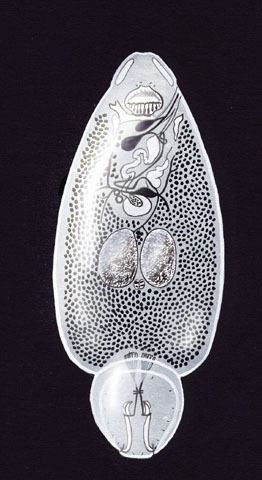Scientific name Entobdella soleae Higher classification Entobdella | Order Capsalidea Genus Entobdella Phylum Platyhelminthes Rank Species | |
 | ||
Similar Capsalidae, Polyopisthocotylea, Monogenea, Diplozoon paradoxum, Neobenedenia | ||
Entobdella soleae is a monogenean (Platyhelminth) skin parasite of the common sole, Solea solea, an important food fish. Typically 2-6 parasites are found on wild sole, but in intensive fish farms this can rise to 200-300 parasites per fish, causing skin inflammation and sometimes death of the sole. E. soleae can live up to c.120 days in seawater.
Contents
Larvae
Entobdella soleae larvae are called oncomiracidia. They are free-swimming and ciliated. These oncomiracidia are likely to attach to the host's upper surface where it migrates forwards toward the fish head, and then migrates to the underside of the sole where it remains.
Attachment
Entobdella soleae utilizes suction through a posterior disc-shaped haptor to achieve semi-permanent attachment to the skin of the sole.
Detachment
The characteristic of the pad tegument might demonstrate a possible role in detachment of the parasite to the host. These features include an isolated tegument and the microvillous surface network of the pad tegument.
Adhesive pad
The surface of the adhesive pads of E. soleae is encompassed by tegument that contains perforations of numerous rod-carrying ducts through pepper-pot apertures and ducts of spheroidal secretory bodies. Rods are distributed uniformly and intensely electron-dense within their ducts. Spheroidal secretory bodeies are both tightly packed and has less electron density than rods. Moreover, the tegument on the surface of the parasite is isolated from the general tegumentary syncytium by a cell boundary. The tegument also contains secretory bodies.
Cement
A 4-5 µm layer of cement bonds the adhesive pad of E. soleae via tegumental microvilli and the sole’s epidermal furrows during attachment. Rod-shaped secretory bodies are the major substance of the cement.
Locomotion
During locomotion on the skin of the sole, the anterior region of E. soleae temporarily attaches to the skin via two pads through an adhesive secretion. These adhesive pads contain two glandular secretions packaged in rods and spheroidal bodies. The locomotion step of E. soleae on the skin sole starts through elongation of the body with the haptor attached. Before attachment of the adhesive pads to the sole skin, liquid spheroidal bodies quickly spreads across the surface of the adhesive pads as well as bundles of rod-like secretory bodies leave the pepper-pot apertures of rod-carrying ducts. The synergy of both secretions produces the cement that binds the parasite to the host.
Egg
Adult E. soleae lays tetrahedral eggs that have a tanned protein shell. A detachable operculum constitutes one of the tetrahedron corners of the egg. The cap-like operculum is bonded to the rest of the egg-shell by a thin cement layer. The opercular bond is strong in which operculum detachment only occurs through the actions of oncomiracidium and the secretion of hatching fluid by glands from the head region. The oncomiracidium of E. soleae escapes through an aperture of the operculum during hatching.
The egg-shell of E. soleae has a similar structural appearance to Fasciola hepatica but without a membrane on the egg-shell lining. Egg-shell is produced by integration of shell material droplets from vitelline cells. Hatching of the egg occurs via chemical removal of the opercular cement and physical rupture of the rest of the egg-shell and opercular bond.
Fixed behaviors
The post-larval migration of E. soleae on the host’s surface ranges from 10–40 days where maintenance of navigational signals must remain intact over the entire period of migration.
Egg hatching of E. soleae induces a releaser response where the larva swims up and down the water column in the ocean to find the sole host.
During migration, E. soleae larva utilizes the physical features of the host’s scales as guidance for movement towards the head. The haptor attaches to the host’s scales as a lock and key mechanism where the axis of the haptor aligns with the longitudinal axis of the sole towards the head.
E. soleae demonstrate host-specific behavior by attaching to the sole epidermis by the presence of sole mucous cells.
Hatching strategies
E. soleae consist of two hatching strategies: quick hatching in the presence of sole skin mucus and spontaneous hatching in the absence of the host. During the natural cycle of illumination, egg hatching is rhythmical where most larvae emerge a few hours after dawn. When fully developed eggs are in contact with sole body mucus during the illumination cycle, hatching is enhanced. The enhanced egg hatching indicates that the sole body mucus contains a potent hatching stimulant.
